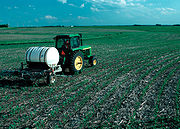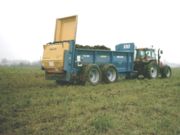
Nutrient management
Encyclopedia

Manure
Manure is organic matter used as organic fertilizer in agriculture. Manures contribute to the fertility of the soil by adding organic matter and nutrients, such as nitrogen, that are trapped by bacteria in the soil...
, commercial fertilizer
Fertilizer
Fertilizer is any organic or inorganic material of natural or synthetic origin that is added to a soil to supply one or more plant nutrients essential to the growth of plants. A recent assessment found that about 40 to 60% of crop yields are attributable to commercial fertilizer use...
, or other form of nutrients) to plants. The purpose is to supply plant nutrients for optimum forage
Fodder
Fodder or animal feed is any agricultural foodstuff used specifically to feed domesticated livestock such as cattle, goats, sheep, horses, chickens and pigs. Most animal feed is from plants but some is of animal origin...
and crop
Agriculture
Agriculture is the cultivation of animals, plants, fungi and other life forms for food, fiber, and other products used to sustain life. Agriculture was the key implement in the rise of sedentary human civilization, whereby farming of domesticated species created food surpluses that nurtured the...
yields, to minimize nonpoint source pollution
Nonpoint source pollution
Nonpoint source pollution refers to both water and air pollution from diffuse sources. Nonpoint source water pollution affects a water body from sources such as polluted runoff from agricultural areas draining into a river, or wind-borne debris blowing out to sea. Nonpoint source air pollution...
(runoff
Surface runoff
Surface runoff is the water flow that occurs when soil is infiltrated to full capacity and excess water from rain, meltwater, or other sources flows over the land. This is a major component of the water cycle. Runoff that occurs on surfaces before reaching a channel is also called a nonpoint source...
of pollutants to surface water
Surface water
Surface water is water collecting on the ground or in a stream, river, lake, wetland, or ocean; it is related to water collecting as groundwater or atmospheric water....
) and contamination of groundwater
Groundwater
Groundwater is water located beneath the ground surface in soil pore spaces and in the fractures of rock formations. A unit of rock or an unconsolidated deposit is called an aquifer when it can yield a usable quantity of water. The depth at which soil pore spaces or fractures and voids in rock...
, and to maintain and/or improve the condition of soil
Soil
Soil is a natural body consisting of layers of mineral constituents of variable thicknesses, which differ from the parent materials in their morphological, physical, chemical, and mineralogical characteristics...
.
Nutrient management plan

Soil conservation
Soil conservation is a set of management strategies for prevention of soil being eroded from the Earth’s surface or becoming chemically altered by overuse, acidification, salinization or other chemical soil contamination...
practices designed to use fertilizer and/or manure to effectively provide needed crop nutrients while protecting against the potential adverse impacts of manure, erosion
Erosion
Erosion is when materials are removed from the surface and changed into something else. It only works by hydraulic actions and transport of solids in the natural environment, and leads to the deposition of these materials elsewhere...
and organic byproducts on water quality
Water quality
Water quality is the physical, chemical and biological characteristics of water. It is a measure of the condition of water relative to the requirements of one or more biotic species and or to any human need or purpose. It is most frequently used by reference to a set of standards against which...
. When such a plan is designed for animal feeding operations (AFO) it may be termed a "manure management plan." The plans may address:
- soil testing
- Plant tissue testPlant tissue testThe nutrient content of a plant can be assessed by testing a sample of tissue from that plant. These tests are important in agriculture since fertilizer application can be fine-tuned if the plants nutrient status is known. Nitrogen most commonly limits plant growth and is the most managed...
ing - manure testing
- erosion controlErosion controlErosion control is the practice of preventing or controlling wind or water erosion in agriculture, land development and construction. Effective erosion controls are important techniques in preventing water pollution and soil loss.-Introduction:...
practices - According to the soil pH the recommend dose may be varying.
- timing of fertilizer/manure application.
In the United States
United States
The United States of America is a federal constitutional republic comprising fifty states and a federal district...
some regulatory agencies recommend or require that farms implement these plans, in order to prevent water pollution
Water pollution
Water pollution is the contamination of water bodies . Water pollution occurs when pollutants are discharged directly or indirectly into water bodies without adequate treatment to remove harmful compounds....
. The U.S. Natural Resources Conservation Service
Natural Resources Conservation Service
The Natural Resources Conservation Service , formerly known as the Soil Conservation Service , is an agency of the United States Department of Agriculture that provides technical assistance to farmers and other private landowners and managers.Its name was changed in 1994 during the Presidency of...
(NRCS) has published guidance documents on preparing a comprehensive nutrient management plan
Comprehensive nutrient management plan
Comprehensive nutrient management plans have become an integral part of the regulatory permitting and environmental stewardship for large, and in some cases medium and small, animal feeding operations . A CNMP is developed to assist an AFO owner/operator in meeting applicable local, tribal,...
(CNMP) for AFOs.
See also
- Agricultural wastewater treatmentAgricultural wastewater treatmentAgricultural wastewater treatment relates to the treatment of wastewaters produced in the course of agricultural activities. Agriculture is a highly intensified industry in many parts of the world, producing a range of wastewaters requiring a variety of treatment technologies and management...
- Ecosan
- FertilizerFertilizerFertilizer is any organic or inorganic material of natural or synthetic origin that is added to a soil to supply one or more plant nutrients essential to the growth of plants. A recent assessment found that about 40 to 60% of crop yields are attributable to commercial fertilizer use...
- Nutrient budgetingNutrient budgetingNutrient budgeting is used in agriculture.The process involves balancing nutrients coming into the farming system with those leaving. The aim is to prevent pollution events and save costs by precisely matching the nutrient requirements of the crop with application of organic and inorganic...
- Nutrient pollutionNutrient pollutionNutrient pollution, a form of water pollution, refers to contamination by excessive inputs of nutrient. It is a primary cause of eutrophication of surface waters, in which excess nutrients, usually nitrogen or phosphorus, stimulate algal growth...
External links
- CNMP Watch – Directory of NMP requirements in various U.S. states
- EPA - Animal Feeding Operations – Federal water permit requirements for AFOs
- National eXtension Manure Nutrient Management Articles
- http://www.willingtoncropservices.co.uk/case_study_gps-soil-sampling-nutrient-mapping.htm Case study in UK of nutrient management.

